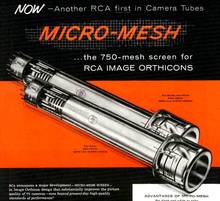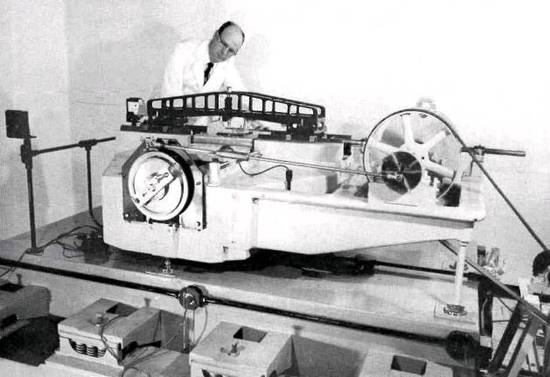Ein Artikel aus den "BROADCAST NEWS" der RCA 1956
Vol. No. 91 - October, 1956 - BROADCAST NEWS published by RADIO CORPORATION OF AMERICA BROADCAST & TELEVISION EQUIPMENT DEPARTMENT CAMDEN. NEW JERSEY
.
RCA NOW USING 750-MESH SCREEN IN TV CAMERA TUBES
Two improved image "orthicon" television camera tubes - the RCA-5820 for black and white and the RCA-6474 for three-tube color cameras - are now being quantity produced for the broadcasting industry with Micro-Mesh, a 750-line per inch mesh screen, replacing the 500-mesh screen heretofore standard in both tube types.
- Anmerkung : Dieser Artikel ist aus dem RCA-Werbeblättchen von 1956 entnommen. Darin wird natürlich nicht über die Schwächen der gesamten "orthicon"-Technik referiert. Auch unsere "Doktoren" bei der Fese laborierten bis 1967 mit 3 und dann sogar 4 orthicons in den ersten Fese- Farbkamera- Prototypen, bis sie merken mussten, das geht so nicht. Der Mikrofonie-Effekt, auch bei den zugekauften Röhren, die aus USA und England importierten Muster-Exemplare, "lernte" das Bild schwimmen, auch in den USA.
Doch dort kannten sie es 1956 nicht besser - Hauptsache war bunt. Das Plumbikon war noch nicht erfunden. Und Philips hatte bereits 1959/1960 die ganzen ebenfalls selbst hergestellten Orthicons aus dem Verkehr gezogen, es aber dem Fese Partner in Darmstadt nicht verraten. Philips / Norelko räumte mit den Plumbicon- Kameras den gesamten US- Kamera- Markt gnadenlos ab.
The 750 mesh eliminates all traces of bothersome noise patterns. Although mesh up to 1,000 lines per inch has been produced by RCA, requirements of the present 525-line television system are exceeded with camera tubes employing the new 750 mesh. Laboratory and field tests have shown that mesh of 750 lines per inch is more than adequate.
.
- Anmerkung : Die Amerikaner haben bis zum bitteren Ende der Analogtechnik nie zwischen Zeilen und Linien unterschieden, es waren immer nur "lines", erst ziemlich spät, als die Europäer das ganz genau wissen wollten, gab es die Anzahl "lines" und dann zusätzlich die Anzahl "tv-lines", die wirkliche Zeilen-Zahl.
.
Details :
To achieve the goal of a 750-mesh screen, it was necessary for RCA to develop its own mesh-making techniques and equipment. Included in the work was the design of an amazingly accurate ruling engine to produce the "master" matrices from which the gossamer-like (Spinnfäden) screen can be produced in quantity.
These meshes (die Netze) are made by an electro-deposition process, using grooves ruled in a glass master as a form. An acid-resistant wax coating is first applied to optically flat glass. Using a suitably shaped stylus or tool, the wax is then ruled with perpendicular sets of parallel lines.
When the ruling has been completed, the glass is etched, cleaned and covered with a thin metallic layer using a sputtering process. The surface layer is then removed by rubbing with a plastic material.
This leaves only the metal in the etched grooves. An electroplating process forms the mesh which is then removed from the glass master.
Obviously, the ruling of the mesh master is a critical step in mesh manufacture and is accomplished using the new ruling engine. Operation of the ruling engine involves the shuttling motion of a diamond stylus moving back and forth on lubricated crossways.
As the stylus shuttles back and forth, it presses very lightly on the glass mesh master. The stylus cuts only in one direction, lifting when a cutting stroke has been completed and returning for the next stroke.
A lead screw moves tie glass mesh master the required distance laterally during the return stroke. The width, depth, contour and spacing of these ruled lines must meet very exacting requirements to insure that each line will be identical with the next.
So fine is the grid forming the mesh that the minute openings represent more than 60 per cent of the total area of the screen. It is through these openings that electrons must pass to reach the vital "target" of the image orthicon and create the television signal.
.


